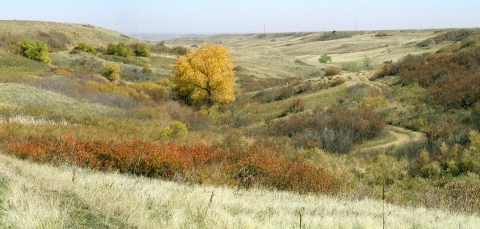Visit Us
Rocky Flats National Wildlife Refuge is a sanctuary away from the hustle and bustle of busy urban life where time moves at nature's pace. With its expansive views, wildlife viewing opportunities, and recreation activities, it's easy to take a nature escape!
Activities
- Wildlife Viewing
- 15 miles of hiking trails
- Bicycling
- Horseback riding
- Cross country skiing
- Snowshoeing
- Archery Range
Visiting the Refuge is FREE! For Refuge hours see Location and Contact Information below. View the Refuge Trails and General Brochure - English, Spanish.
Archery Range: Access the range from the South Woman Creek Trail. See the Trails and General Brochure map above with archer symbol for location.
Know Before You Go: Check out the Refuge Rules and Policy page to recreate responsibly. Remember to stay on the trails, only service dogs are allowed at the Refuge, no swimming or wading at Refuge lakes, bicycles and Class 1-ebikes are permitted on the trails.
Rocky Flats National Wildlife Refuge is part of the Colorado Front Range National Wildlife Refuge Complex. For questions about the Refuge, please call Refuge Headquarters at Rocky Mountain Arsenal National Wildlife Refuge at 303-289-0232.
Location and Contact Information
About Us
Established in 2007, Rocky Flats National Wildlife Refuge was created in part to preserve and protect more than 630 species of plants, as well as the globally rare xeric tallgrass prairie.
The Refuge has striking vistas of the Front Range of the Rocky Mountains and rolling prairie grasslands, woodlands, and wetlands. It is home to 239 migratory and resident wildlife species, including prairie falcons, deer, elk, coyotes, songbirds, and the federally threatened Preble’s meadow jumping mouse, and provides a protected corridor for migrating wildlife.
What We Do
Wildlife conservation is at the heart of the National Wildlife Refuge System. It drives everything on U.S. Fish and Wildlife Service lands and waters managed within the Refuge System, from the purposes for which a national wildlife refuge national wildlife refuge
A national wildlife refuge is typically a contiguous area of land and water managed by the U.S. Fish and Wildlife Service for the conservation and, where appropriate, restoration of fish, wildlife and plant resources and their habitats for the benefit of present and future generations of Americans.
Learn more about national wildlife refuge is established to the recreational activities offered to the resource management tools used. Using conservation best practices, the Refuge System manages Service lands and waters to help ensure the survival of native wildlife species.
At Rocky Flats National Wildlife Refuge we are working for wildlife to ensure that our natural resources are conserved for current and future generations to enjoy.





